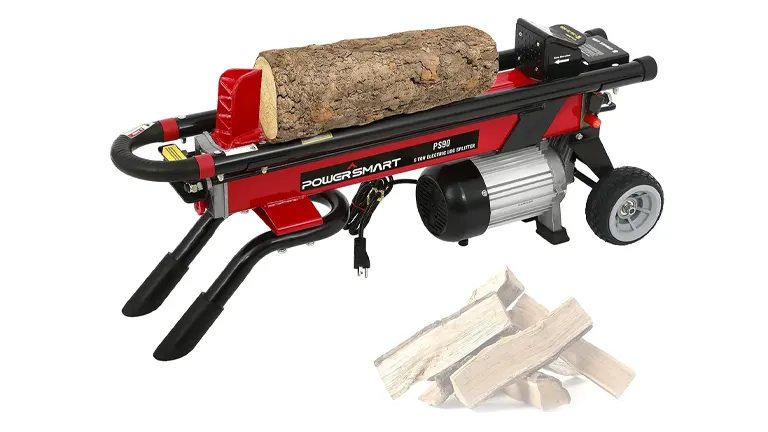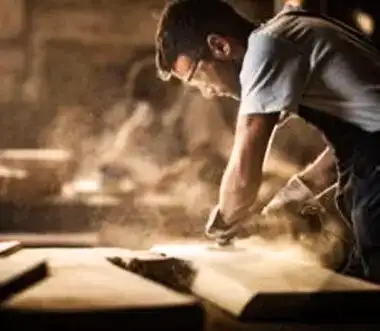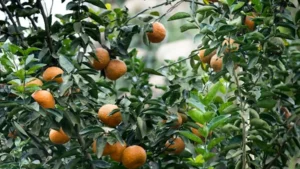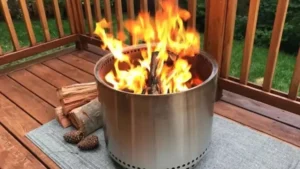Why Is My Log Splitter Running Slow?
- February 7, 2025
- 0 comment

A slow log splitter can turn a simple task into a long, frustrating job. If your machine isn’t working like it used to, it’s important to understand the possible causes and find the right fix.
There are several reasons why your log splitter might be running slow. From low hydraulic fluid to a dull wedge, small issues can lead to bigger performance problems. This guide will help you identify the common reasons behind the slowdown and how to solve them.
1. Low Hydraulic Fluid
Hydraulic fluid is what powers the log splitter. Without enough of it, the machine can’t generate the power it needs to push the ram through the logs. If your splitter is running slowly, the first thing to check is the hydraulic fluid level. Low fluid levels mean less power, which leads to slower operation.
What to Do:
- Check the hydraulic fluid reservoir. If it’s low, fill it up.
- Make sure you’re using the correct type of hydraulic fluid for your log splitter. The wrong type can affect performance.
- If the fluid looks dirty or old, it might be time to change it.
2. Clogged or Dirty Hydraulic Filter
The hydraulic filter keeps dirt and other debris out of the hydraulic system. Over time, this filter can get clogged, making it harder for the hydraulic fluid to flow through. When this happens, your log splitter will run slower because the fluid can’t move as quickly as it should.
What to Do:
- Locate the hydraulic filter and check for clogs or dirt buildup.
- If the filter is dirty, clean or replace it.
- Regularly replacing the filter can prevent future issues.
3. Air in the Hydraulic System
Air in the hydraulic system can cause your log splitter to lose power and run slower. This can happen if you’ve recently changed the hydraulic fluid or if the splitter hasn’t been used in a while. Air bubbles reduce the pressure in the system, slowing down the ram.
What to Do:
- Bleed the hydraulic system to remove any trapped air. Your owner’s manual should have instructions on how to do this for your specific log splitter model.
- After bleeding the system, check the hydraulic fluid level again and top it off if needed.
4. Worn-Out Hydraulic Pump
The hydraulic pump is the heart of your log splitter’s power system. Over time, the pump can wear out or get damaged, reducing the amount of pressure it can generate. This is a more serious issue and can cause the log splitter to lose a lot of speed or stop working entirely.
What to Do:
- If the hydraulic pump is worn out, you’ll likely need to replace it.
- Inspect the pump for any visible damage. If you’re not sure how to check it, consult a professional.
5. Hydraulic System Leaks
Leaks in the hydraulic system will reduce the amount of pressure available to power the ram. If you notice hydraulic fluid pooling around the machine or notice a steady drip, a leak is probably the reason your splitter is running slow.
What to Do:
- Inspect the hydraulic lines, hoses, and seals for leaks.
- Tighten any loose connections and replace worn seals or damaged hoses.
- Fixing even small leaks can significantly improve performance.
6. Engine Running at Low Speed
If the engine powering the hydraulic pump isn’t running at full speed, the splitter won’t have enough power to split logs efficiently. Many log splitters have an adjustable throttle, and if it’s set too low, the splitter will run slowly.
What to Do:
- Check the engine’s throttle settings. Make sure the engine is running at the recommended speed.
- Look at the owner’s manual to find the correct RPM settings and adjust accordingly.
7. Tough Logs
Sometimes the issue isn’t with the log splitter itself but with the logs you’re trying to split. Harder wood or logs with a lot of knots can take longer to split and make the machine seem like it’s running slower than it actually is.
What to Do:
- Try splitting smaller or less knotty sections of the log first.
- Make sure the logs are positioned correctly to get the best performance out of your splitter.
- If the wood is too tough, you may need to use a more powerful log splitter.
8. Dull Wedge
The wedge is the part of the log splitter that actually splits the wood. If the wedge is dull or damaged, it will take more effort to push through the log, making the splitter work harder and run slower.
What to Do:
- Inspect the wedge for dullness or damage. Sharpen or replace it if needed.
- Regularly maintaining the wedge by sharpening it can keep your log splitter running at full speed.
Regular Maintenance of Log Splitter for Peak Performance
Taking care of your log splitter regularly helps it run smoothly and prevents it from slowing down. Here are a few simple tasks you can do to keep your machine in good shape:
- Check Hydraulic Fluid Regularly
The hydraulic fluid powers your log splitter. Low or dirty fluid can cause the machine to lose power. Always check the fluid level before using the splitter, and top it off if needed. It’s also important to change the fluid when it gets dirty. - Inspect for Leaks
Leaks in the hydraulic system can make your log splitter run slower. Look for any signs of fluid leaks around the hoses, seals, and connections. Fixing a leak early can prevent bigger problems and keep the machine working properly. - Clean or Replace Filters
The hydraulic filter keeps dirt and debris out of the system. If it gets clogged, the fluid can’t flow freely, making the machine work harder. Check the filter regularly and clean or replace it to ensure smooth operation. - Sharpen the Wedge
A sharp wedge splits logs faster and puts less strain on the machine. Over time, the wedge can get dull, especially when splitting hard or knotty wood. Sharpen the wedge regularly to keep the splitter running efficiently.
By doing these basic maintenance tasks, you can avoid common problems and keep your log splitter working at its best for a long time.
When to Call a Professional
If you’ve tried all the basic fixes and your log splitter is still running slow, it might be time to get help from a professional. Some issues, like complicated hydraulic problems or engine troubles, are hard to fix without the right tools or knowledge. Attempting these repairs on your own could make the problem worse or even damage your machine.
A trained technician can inspect your log splitter, figure out what’s wrong, and fix it properly. They have the experience and equipment to handle more complex problems like hydraulic pump failures or major engine issues. By calling a professional, you can avoid causing further damage and get your splitter back to working condition quickly.
If you’re not sure what the issue is or don’t feel confident doing the repairs yourself, it’s best to let an expert take a look. This can save you time, money, and frustration in the long run.
Conclusion
A slow log splitter can be frustrating, but with regular maintenance and some simple checks, you can usually fix the problem. By keeping the hydraulic fluid topped off, checking for leaks, cleaning filters, and sharpening the wedge, you can ensure your log splitter runs smoothly.
If these fixes don’t solve the issue, don’t hesitate to call a professional to avoid bigger problems. With proper care and attention, your log splitter can continue to make your wood-splitting tasks quick and easy.
Frequently Asked Questions
1. Why is my log splitter running slow?
Your log splitter might be running slow due to low hydraulic fluid, a clogged filter, air in the system, or a dull wedge. Regular maintenance can often fix these problems.
2. How often should I check the hydraulic fluid?
It’s a good idea to check the hydraulic fluid level before each use. Also, check the fluid’s condition and replace it if it looks dirty or contaminated.
3. What type of hydraulic fluid should I use?
Always use the hydraulic fluid recommended by the manufacturer. Using the wrong fluid can affect performance and damage the machine.
4. How do I know if there’s air in the hydraulic system?
If your log splitter is running slow after changing the fluid or after sitting unused for a while, there might be air in the system. Bleeding the hydraulic system can remove the air and restore performance.
5. What should I do if I find a hydraulic fluid leak?
If you find a leak, inspect the hoses, seals, and connections for damage. Replace any worn-out parts and tighten any loose connections to stop the leak.
6. How do I sharpen the wedge on my log splitter?
You can use a file or a grinder to sharpen the wedge. Make sure to remove any nicks or dull spots to keep it cutting through wood easily.
7. How often should I change the hydraulic filter?
The hydraulic filter should be checked regularly and replaced when it becomes dirty or clogged. Follow the manufacturer’s guidelines for specific intervals.
8. Why does my log splitter struggle with large or tough logs?
Large or knotty logs require more power to split. If your log splitter is struggling, it might be due to a dull wedge or reduced hydraulic pressure.
9. Can I fix hydraulic pump problems myself?
Hydraulic pump issues are complex and usually require a professional to repair. Trying to fix a pump without the right knowledge could cause more damage.
10. When should I call a professional for my log splitter?
If basic fixes like checking fluid levels, cleaning filters, or sharpening the wedge don’t solve the problem, it’s best to call a professional. Complex hydraulic or engine issues need expert attention.
We hope this guide on why your log splitter might be running slow has helped you understand how to keep your machine in top condition. Regular maintenance ensures better performance, longer life, and less downtime for your log splitter.
If you have any tips or experiences, feel free to share them in the comments below. Don’t forget to share this article with others who use log splitters to help them avoid slowdowns. Stay safe and keep splitting!

Edward Smith
Forestry AuthorWoodworking is about more than crafting; it's a harmonious connection with nature, mastering tools, and preserving our environment. I'm here to share my knowledge and experiences with you, forging a future where we can embrace wood's beauty and utility while safeguarding our forests' health and diversity.













Leave your comment